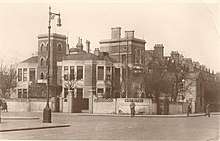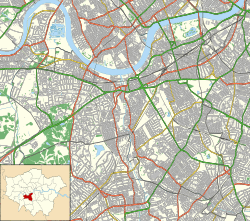Battersea General Hospital
| Battersea General Hospital | |
|---|---|
 Battersea General Hospital | |
 Location within Wandsworth | |
| Geography | |
| Location | Battersea, London, England, United Kingdom |
| Coordinates | 51°28′30″N 0°09′50″W / 51.4751°N 0.1640°WCoordinates: 51°28′30″N 0°09′50″W / 51.4751°N 0.1640°W |
| History | |
| Founded | 1902 |
| Closed | 1972 |
| Links | |
| Lists | Hospitals in England |
Battersea General Hospital, known locally as the "Antiviv" or the "Old Anti," was a hospital in Battersea, London.
History
The hospital was founded in 1896 by Theodore Russell Monroe, secretary of the Anti-Vivisection Society. The hospital was notable for not allowing animal experiments to take place in its facilities, and for refusing to employ physicians who were involved in or approved of animal research.[1]
Based at 33 Prince of Wales Drive, Battersea Park, it first opened for in-patients in 1903, with 11 beds for adults and 4 for children. It faced opposition from the medical establishment, who regarded the hospital's existence as "a great slur upon the profession."[2] Because of difficulties attracting funding – its stance made it ineligible for grants from the King Edward's Hospital Fund – it lost its anti-vivisection charter in 1935. It joined the new National Health Service (NHS) in 1948, was closed by the NHS in 1972, and its building was demolished in 1974.[1]
See also
Notes
- 1 2 "Battersea General Hospital". Lost hospitals of London. Retrieved 14 July 2018.
- ↑ Kean, Hilda. "The 'Smooth Cool Men of Science': The Feminist and Socialist Response to Vivisection", History Workshop Journal, 1995, 40, p. 22.
Further reading
- Lansbury, Coral. The Old Brown Dog: Women, Workers, and Vivisection in Edwardian England. University of Wisconsin Press, 1985.